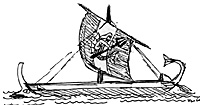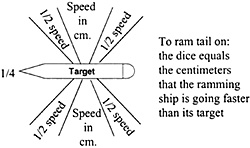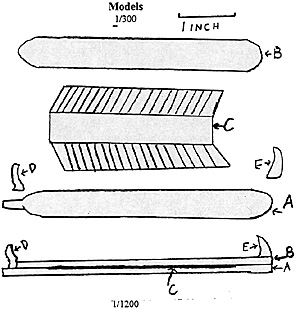Notes on Models
 There are commercially available models of Greek triremes. For those of us who would rather make our own models there are a number of options. The simplest model to make is a simple flat silhouette showing the hull and oars. i have provided an example in 1/1200 scale. Mounted on a thin balsa or cardboard backing, it is a very functional playing piece. It lacks visual appeal, however, but then, so do most of my models. A side view silhouette of a trireme mounted upright on the flat hull adds a little more visual appeal. Remember, the ships did not have sails when fighting. They were oar powered.
There are commercially available models of Greek triremes. For those of us who would rather make our own models there are a number of options. The simplest model to make is a simple flat silhouette showing the hull and oars. i have provided an example in 1/1200 scale. Mounted on a thin balsa or cardboard backing, it is a very functional playing piece. It lacks visual appeal, however, but then, so do most of my models. A side view silhouette of a trireme mounted upright on the flat hull adds a little more visual appeal. Remember, the ships did not have sails when fighting. They were oar powered.
A wood/cardboard model can be made simply. Cut out a 1/16 inch balsa hull shaped like the hull profile (A). Then glue a cardboard set of oars on top (C). Cut the cardboard so it looks like oars. Place another 1/16 inch hull (B) profile on top of the oars. This layer should not have a ram. Add a piece of balsa to the bow (D) and stern (E) to complete the structure. My models in 1/300 scale are made of balsa and cardboard, but I noticed that popsicle sticks are about the right size and shape. I painted my models gloss black. A better paint job would feature a pair of eyes on the bow and a bright paint job. I have provided some drawings to illustrate. My balsa/cardboard models have stood up to use and abuse since 1981 but are a little battered around the edges. Don Featherstone and Paul Hogue both provide instructions for building models of ancient warships in their books on naval wargames.
Rules – Ancient Naval Battle – Salamis
Most of the rules I looked at had a lot of things that the accounts did not mention: missiles like archery or catapults, and boarding etc. They skipped things the accounts do mention – ramming of enemy and friendly ships, oars getting fouled, and the coastline constricting movement. Rather than offer revisions to other rules, it was easier to just start from scratch. Feel free to tinker and adjust these. One note, however, if these rules produce a messy tangle of collisions and fouled ships, especially among the Persians, that is exactly what they are intended to produce. As nearly as I can picture it, that is what happened.
Moves Top speed is centimeter x nautical miles per hour. For the Greeks, top speed is 8 centimeters a turn. For the Persians, top speed is 7 centimeters. From a standing start the first move is 2/3 of top speed. Second move is top speed. Roll one die (D6) to see how many consecutive turns the ship can sustain top speed. When that number of moves is exhausted, the ship must move at 2/3 speed for ½ of that number of moves before returning to top speed for 2/3 of the original number of turns. Then ½ that number of turns to recover for 1/3 the number at top speed. A ship can only change speed one step up or down a turn – except when rammed, ramming, or having oars sheared. Turns will be on a radius equal to ½ the cm. per move and change direction 90 degrees.
Moves shall be simultaneous with orders for each ship written in advance. Orders shall specify speed, turn or straight, and intent to ram or shear oars. The first orders in the game shall specify the first two moves. After the first move, write orders for the third and continue to write orders for one move ahead of the current move for the rest of the game.
Ramming A ramming can only occur when two ships touch while moving. Dice for a ram.
 Add one point to score if the move order specifies "ram." For example: a ship moving perpendicular to another at full speed, 8 cm. with orders to ram has a "9" for ramming (8 + 1 for ram order). Any die roll will result in a ram. At an angle the ship moving at 8 cm has a 4 + 1 for ramming. A five or lower on the die roll is a ram. A ship moving at 8 cm. from the rear with ram orders has a score of two on a ship moving at 6 cm. plus 1 for ram orders. The die roll must be a 3 or lower to ram. When two ships collide head on, each rolls a number ¼ its speed plus 1 if it has ram orders. Both may ram. When a ship is rammed, both ships stop. The next move, the ramming ship can back off and move out. The rammed ship is declared sunk.
Add one point to score if the move order specifies "ram." For example: a ship moving perpendicular to another at full speed, 8 cm. with orders to ram has a "9" for ramming (8 + 1 for ram order). Any die roll will result in a ram. At an angle the ship moving at 8 cm has a 4 + 1 for ramming. A five or lower on the die roll is a ram. A ship moving at 8 cm. from the rear with ram orders has a score of two on a ship moving at 6 cm. plus 1 for ram orders. The die roll must be a 3 or lower to ram. When two ships collide head on, each rolls a number ¼ its speed plus 1 if it has ram orders. Both may ram. When a ship is rammed, both ships stop. The next move, the ramming ship can back off and move out. The rammed ship is declared sunk.
A ship meeting another ship head on may elect to shear the other's oars if so ordered. To successfully shear, roll (1/4 x speed in cm) + 2 for shear orders. A ship that is successful in shearing cannot be rammed. A ship that is sheared stops and can only go in circles.
Friendly ships that collide shall dice for ramming as above.
When two or more ships moving touch sides, their oars are fouled and they move a step slower next turn. If the way is narrow, they continue to slow down a step turn and remain fouled. If the way widens, they may disengage. Roll a die (D6) to see how many moves it takes to clear.
Grounding
When a ship touches the shore, roll for grounding. Use the same formula as ramming. When grounded, the ship does not move. Roll a die (D6) to see how many turns it is grounded.
You may want to add a weather rule and a morale rule. There are reports that there was a wind from sea to shore and a resulting wave. The Persians are said to have been blown about, but the Greeks were not. Curious. There is no report of any Persian or Greek captain surrendering his or her ship. (There was one woman commanding on the Persian side.) The Persians lost 200 ships; the Greeks 40. There is little dispute about these numbers.
Selected Bibliography
Aeschylus. The Persians
Banks, Arthur A World Atlas of Military History (1973)
Burn, A.R. Persia and the Greeks (1984)
Featherstone, Donald Naval War Games (1975)
Frost, Frank Plutarch's Themistocles, A Historical Commentary (1980)
Hogue, Paul Sea Battles in Miniature (1980)
Herodotus The Histories
Hignett Xerxes's Invasion of Greece (1962)
Lazenby, J.F. The Defense of Greece (1993)
Morrison, J.S. and J.F. Coats The Athenian Trireme (1986)
Nelson, Richard B. The Battle of Salamis (1975)
Plutarch Lives
Rodgers, W.L. Greek and Roman Naval Warfare (1937)
Welch, Frank Building the Trireme (1988)

More Salamis
Back to Table of Contents -- Lone Warrior #129
Back to Lone Warrior List of Issues
Back to MagWeb Magazine List
© Copyright 2000 by Solo Wargamers Association.
This article appears in MagWeb (Magazine Web) on the Internet World Wide Web.
Other military history articles and gaming articles are available at http://www.magweb.com
